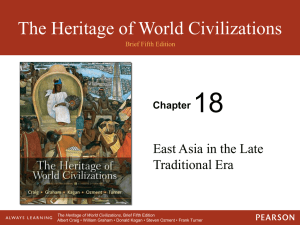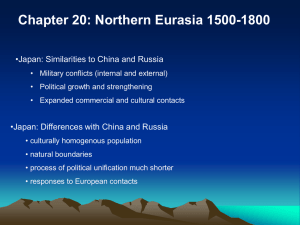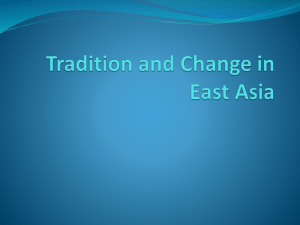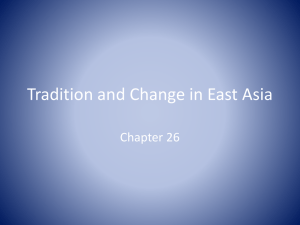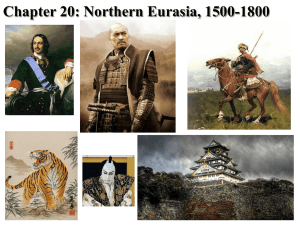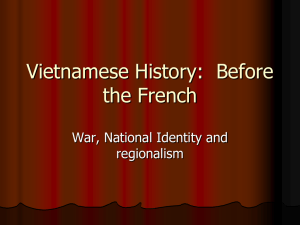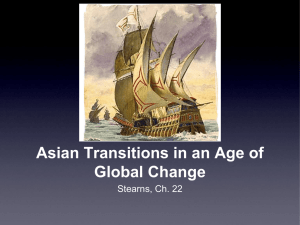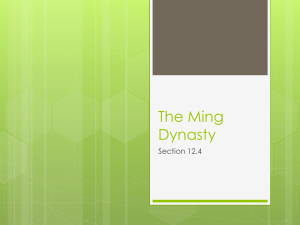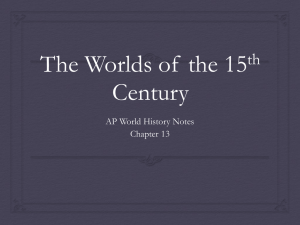Tokugawa Era (1600
advertisement
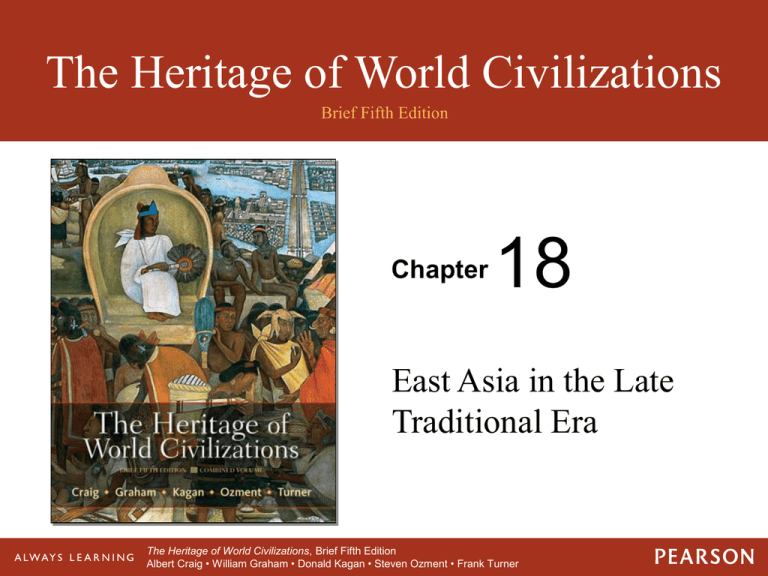
The Heritage of World Civilizations Brief Fifth Edition Chapter 18 East Asia in the Late Traditional Era The Heritage of World Civilizations, Brief Fifth Edition Albert Craig • William Graham • Donald Kagan • Steven Ozment • Frank Turner East Asia in the Late Traditional Era Late Imperial China • Ming (1368–1644) and Qing (1644–1911) Dynasties Japan • Warring States Era (1467–1600) • Tokugawa Era (1600–1868) Korea and Vietnam • Korea • Vietnam Seventeenth-century screen painting of a Shintō river festival Introduction • East Asian countries shared many cultural elements But differed in institutions and history Introduction (cont’d) • Common influence of Confucianism China and Japan were furthest apart Chinese dynastic cycle continued in Ming and Qing Japan’s history was closer in some ways to that of Europe Korea and Vietnam closer to China Global Perspective: East Asia in the Late Traditional Era • What features of Japan or China, other than those mentioned above, bear on their lack of progress from commerce to industry? What other factors presented in the chapters on Europe are relevant? • Why was Tokugawa Japan more open to Western learning than Qing China? Was population a plus, a minus, or a factor that did not matter? Late Imperial China Ming (1368–1644) and Qing (1644–1911) Dynasties Ming and Qing Dynasties: Land and People • Ming-Qing continuities: longest stretch of good government in Chinese history • China’s population doubled from 1368 to 1644 60 million to 125 million 410 million by mid-nineteenth century Ming and Qing Dynasties: Land and People (cont’d) • Increase in food supply Rice and new crops such as maize • Yangzi valley was densely populated • Ming cash crops – silk and cotton Third Commercial Revolution • Expansion between 1500 and 1800 Followed First (Han) and Secont (Song) commercial revolutions Commerce expanded in mid-sixteenth century - Population surge - Relaxation of government controls A porcelain enameled plate Third Commercial Revolution (cont’d) • • • • Stimulus of imported silver Favorable balance of trade Urban growth – mainly market towns Women still restricted by Confucian edicts Spread of footbinding Figure 18–1. A Bound Foot Ming-Qing China: The Emperor • Strong emperors • More direct control Secretariat abolished Personal government • Despotic power • Forbidden Palace, Beijing Rebuilt Centered on emperor’s rule The Thin Horse Market The Thin Horse Market Ming-Qing China: Bureaucracy • Similar to Tang, Song times • Manchus strongly centralize • Revenues restored But fixed Emperors lose out as production rises • Officials, later called “mandarins” Competition to enter civil service Examinations Gentry • More important than in the past • Between bureaucracy and village • District magistrate Lowest level Over population of up to 300,000 by late Ming “Law of avoidance” – placed outside of home province • Urban, not rural, not landed Pattern of Manchu Rule • Manchu (Qing) takeover was smooth Short transition Manchus were already Sinicized • Manchus adopted institutions to maintain themselves as an ethnically elite group Manchu troops segregated Examination Stalls Pattern of Manchu Rule (cont’d) • Dyarchy For each key post, one Chinese, one Manchu • Able Rulers Kangxi: model emperor, patron of culture and learning, encouraged trade Qianlong: Kangxi’s grandson, prosperous rule, but corruption at end Emperor Qianlong Chronology: Late Imperial China Ming Foreign Relations • Vigorous expansion under early Ming Tribute system • Naval exploration under Zheng He First armada – 62 major ships, 28,000 sailors Half century earlier than Portuguese voyages • Chief threat came from Mongols Ming Foreign Relations (cont’d) • Also threat from Japanese and Chinese pirates Ming invasion of Korea in late sixteenth century Map 18–1. The Ming Empire and the Voyages of Zheng Giraffe with Attendant Qing Foreign Relations, Culture • Manchu takeover in 1644 Threat still came from north and northwest • Conquest of Tibet • Increasing European contact Jesuits appeal to Kangxi Christianity later banned • Macartney mission to China Jesuit Missionary Ming-Qing Culture • Increasingly turned inward Reaction to Buddhism under Song Ming-Qing antipathy to Mongol rule • Gu Yanwu Example of intellectual refusing to serve Manchu Philology Works only rediscovered in late 1800s Ming-Qing Culture (cont’d) • Traditional arts favored: painting, calligraphy, poetry, philosophy Japan Warring States Era (1467–1600) Warring States Era (1467-1600) • War of All Against All • Foot Soldier Revolution • Foreign Relations and Trade Japan – Warring States Era • Warring States Era (1467-1600) Ashikaga equilibrium was precarious Warfare among the daimyo “The strong eat and the weak become the meat” • Unification in stages Toyotomi Hideyoshi (1536-1598) Tokugawa Ieyasu (1542-1616) Foot Soldier Revolution • Foot soldier replaced the aristocratic mounted warrior as the backbone of the military Warfare and society changed as well • Daimyo took all land revenue Multigeniture to unigeniture Foot Soldier Revolution (cont’d) • Rise of larger armies – 100,000s New weapons Thrusting spear Musket, from Portuguese Daimyo Castle Societal Transformation • In some respects, Japan resembled postfeudal Europe Most of the military class were soldiers, not aristocrats Military class had reached 7 to 8% of population Recruitment of village warriors added significantly to power of daimyo Commercial growth continued through the dark decades of Warring States period Chronology: Warring States Japan and the Era of Unification (14671600) Foreign Relations and Trade • Increased trade with China Shogun appointed “King of Japan” “Tribute missions” sent to China • Progress of Japanese crafts • “Vermilion-seal trade” after Hideyoshi Arrival of the Portuguese in Japan Foreign Relations and Trade (cont’d) • Seclusion Trade limited to small community of Chinese merchants in Nagasaki Japanese could not leave Japan Large ship construction prohibited • Arrival of European ships – Portuguese Christianity • Jesuit missionaries Jesuits directed efforts towards Samurai 300,000 converts by 1600 • Christianity seen as new Buddhist sect Cosmic Buddha of Shingon and Christian God seen as similar Also Bodhisattva Kannon and Virgin Mary Christianity (cont’d) • Hideyoshi banned Christianity in 1597 Persecutions under Tokugawa Ieyasu Nagasaki uprising in 1637 – 37,000 died Tokugawa Era (1600–1868) Tokugawa Era (1600–1868) • Political Engineering and Economic Growth during the Seventeenth Century Hideyoshi’s Rule Establishment of Tokugawa Rule The Seventeenth-Century Economy Tokugawa Era (1600–1868) (cont'd) • Eighteenth and Early Nineteenth Centuries The Forty-Seven Ronin Cycles of Reform Bureaucratization The Later Tokugawa Economy • Languages of East Asia Tokugawa Era (1600–1868) (cont'd) • Hideyoshi’s rule Problem of dealing with armed peasantry Hideyoshi ordered “sword hunt” in 1588 • Hideyoshi moved to freeze society Marrying within own class Clothing styles dictated • Surveys of lands Standardization of weights and measures Made systematic land tax possible “Picture-treading” Plaque Tokugawa Leyasu • Final unification in 1600 Confiscated lands of defeated enemies Rewarded vassals and allies Reshuffling of domains • Regulation of legal codes • Hostage system Map 18–3. Tokugawa Japan and the Korean Peninsula Tokugawa Leyasu (cont’d) • National policy of seclusion No foreigners to enter Japan • “Bakufu-domain system” Edo Castle Seventeenth-Century Economy • Doubling of agricultural production New techniques and innovations Population grew from 12 million in 1600 to 24 million in 1700 Growth of byproducts: cotton, silk, indigo, lumber • Growth of national economy Taxes Richness and diversity of urban life The Commercial District of Osaka Eighteenth and Nineteenth Centuries • Rate of growth and changes slow Different form of changes began • Forty-seven rōnin Loyalty was deeply internalized State was above ethics Loyalty and idealism applied to women Eighteenth and Nineteenth Centuries (cont’d) • Alternating periods of reform and laxity Reformist cliques of officials Retrench domain’s finances, eliminate extravagance, austere way of life Bureaucracy and Economy • Balance – centralization and decentralization No attempts to overthrow the bakufu • By 1700 the economy approached limit of expansion under available technology Commerce grew slowly Bureaucracy and Economy (cont’d) • Population of 26 million in the eighteenth century Same in mid-nineteenth century Contraception and abortion were commonplace Infanticide in hard times • Scholars disagree about relationship between Tokugawa economy and later rapid industrialization A Closer Look: Bridal Procession • Yohime, the twenty-first daughter of the eleventh shogun, approaches the main Edo estate of the Kaga daimyo. Bridal Procession Tokugawa Culture • New urban culture with merchant influence New secular consciousness • Revitalization of Zen Buddhism Hakuin – 1686-1769 • Two urban cultures Samurai – serious, Chinese styles favored Townspeople – lowbrow popular culture • Bashō (1644-1694) The Narrow Road of Oku Mother Bathing Her Son Literature and Drama • Ihara Saikaku (1642-1693) The Life of an Amorous Man The Life of an Amorous Woman • Chikamatsu Monzaemon (1653-1724) Wrote for Kabuki and puppet theater • Kabuki From 1600s Women forbidden to perform, 1629 More human than Nō Confucian Thought • Tokugawa elite drawn to Confucianism • Difficult task of fitting Confucianism to Japan No room for shogun in Confucianism - Answer – emperor had mandate of heaven – entrusted political authority to shogun Japanese “feudal system” of lord-vassal View of China as central kingdom - Manchus lost claim to universality Confucian Thought (cont’d) • Tremendous intellectual vitality National Studies • Attempt to find in Japanese classics the original true character of Japan before Chinese influence Japanese spirit as free, spontaneous, clean, lofty, honest Chinese spirit as rigid and artificial • Reaffirmation of Japan’s emperor institution National Studies (cont’d) • Weaknesses of National Studies No substitute for philosophy Chiefly literary Chronology: Tokugawa Era (1600-1868) Dutch Studies • Ban on Western books lifted in 1720 Recognition that Western anatomy texts were better than Chinese ones • Also interest in Western astronomy, geography, botany, physics, chemistry, art • Expanded into Western Studies during 1860s Korea and Vietnam Korea Korea and Vietnam: Introduction • Chinese influences on Korea and Vietnam Writing Government Buddhism Confucianism • Points of differentiation Language Independence Map 18–4. Early Korean States. Early Korea • Peninsular geography shaped history • Chinese commanderies (108 B.C.E. – 313 C.E.) • Three Korean states (313 C.E. – 668 C.E.) Silla, Paekche, and Koguryo Silla unified, ruled others (668 – 918 C.E.) Chinese army helped with unification Early Korea (cont’d) • Silla drove Chinese out Silla became autonomous tribute state to China Koryo Dynasty (918–1392) • Cultural brilliance Celadon vases, first history (1145), poetry and literature, moveable type • Buddhism Buddhist infrastructure, art, and scholarship Koryo Dynasty (918–1392) (cont’d) • Chinese influence on government offices and laws Weak society, many slaves Weak economy based on barter Weak state dominated by military Tributary to China Pulguksa temple Korea: Choson Era • Yi Songgye founded Choson dynasty (1392–1910) Tied to stability of Ming-Qing China • Yangban – elite families Monopolized education and elite posts • King Sejong (1418–1450) Supported scholarship and reforms • Acceptance of Neo-Confucianism Korea: Invasions • Korea impacted by invasions Japanese under Hideyoshi – 1592, 1596 Ming troops Manchu troops – 1627, 1637 • Famine, death and misery Internal struggles between royal officials • Literacy rose Cultural achievements, women writers Call for “practical learning” A Badge of Rank Chronology: Korean History Vietnam Vietnam • Vietnam in Southeast Asia • Vietnamese Origins • A Millennium of Chinese Rule: 111 B.C.E.– 939 C.E. • An Independent Vietnam • The Marck South Vietnam – Overview • Four historical movements shaped all of Southeast Asia Peoples, languages followed river valleys north to south Indian traders and missionaries, first to fifteenth centuries, brought Buddhism and other influential ideas Vietnam – Overview (cont’d) • Four historical movements shaped all of Southeast Asia Arab and Indian traders, thirteenth to fifteenth centuries, introduced Islam Chinese diaspora, especially after 1842, formed urban merchant class • Fifth movement shaped Vietnam Conquest by China Creation of Vietnam • Geography “Two baskets on a carrying pole” Vietnamese, Cham, and Khmer peoples • Chams More similar to Indonesians than Vietnamese Champa Seafarers Creation of Vietnam (cont’d) • Khmers (Cambodians) In modern south Vietnam • Early history based only on archaeology Bronze from first millennium B.C.E. Bronze drum Map 18–6. Vietnam and Neighboring Southeast Asia Chinese Rule (111 B.C.E.–939 C.E.) • Nan Yueh state formed 208 B.C.E. Controlled southeast China and Red River basin Ruled by China (111 B.C.E.–939 C.E.) Chinese Rule (111 B.C.E.–939 C.E.) (cont’d) • Social change Chinese cultural influence, especially under Tang Revolt led to independence, 939 Ly (1009–1225) and Tran (1225–1400) dynasties Formal tribute relationship with China Vietnam: Second Millennium • Vietnamese dynastic blocks Ly (1009-1225) Tran (1225-1400) Le (1428-1787) Nguyen (1802-1880s) • Not centralized bureaucratic states Tensions between center and periphery • Problem of Chinese invasions Vietnamese formal submission to China Chronology: Vietnamese History Fifteenth Century Developments • Two momentous developments • Increased use of Chinese institutions and culture to strengthen the government Reforms of Le Thanh Tong (1442–1497) - Neo-Confucian learning, public works - Civil service exams – weakened nobles Fifteenth Century Developments (cont’d) • Destruction of the Champa state By Le Tranh Tong in 1471 “The march to the south” • Nguyen conquest of north, 1802 Nguyen Dynasty, capital at Hue Hue Review Questions 1. What factors led to economic and population growth in late traditional China? Was the pattern the same in Japan during those centuries? Review Questions 2. How was Manchu rule like Mongol rule during the Yuan Dynasty? How was it like the rule by Chinese emperors during the Ming? Review Questions 3. What were the social and administrative foundations of the absolute power of Ming–Qing emperors? Review Questions 4. Compare and contrast the bureaucracies of China and Japan in this period. What influences might you expect their differences to have on the later histories of these countries? Review Questions 5. How did advances in military technology change warfare in sixteenth-century Japan? How was the strategic balance of power reflected in the government created by Tokugawa Ieyasu? Review Questions 6. Did literacy ruin the samurai or improve them? How did literate samurai “fit” the changed society of the late eighteenth century? Review Questions 7. What was Dutch Studies? With what ideas did Dutch Studies compete, and why is it important? Review Questions 8. Who were the yangban, and how did they influence Korean history? Review Questions 9. How and why did Vietnam expand to the south? Review Questions 10.Summarize the relationship between Vietnam and China and between Korea and China. Was either relationship stronger or more significant? Explain.
